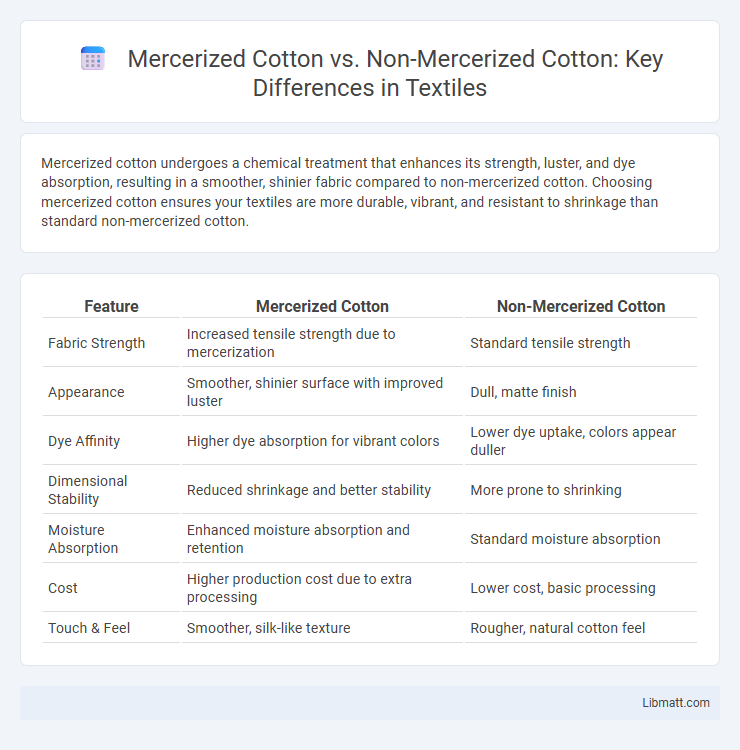Mercerized cotton undergoes a chemical treatment that enhances its strength, luster, and dye absorption, resulting in a smoother, shinier fabric compared to non-mercerized cotton. Choosing mercerized cotton ensures your textiles are more durable, vibrant, and resistant to shrinkage than standard non-mercerized cotton.
Table of Comparison
| Feature | Mercerized Cotton | Non-Mercerized Cotton |
|---|---|---|
| Fabric Strength | Increased tensile strength due to mercerization | Standard tensile strength |
| Appearance | Smoother, shinier surface with improved luster | Dull, matte finish |
| Dye Affinity | Higher dye absorption for vibrant colors | Lower dye uptake, colors appear duller |
| Dimensional Stability | Reduced shrinkage and better stability | More prone to shrinking |
| Moisture Absorption | Enhanced moisture absorption and retention | Standard moisture absorption |
| Cost | Higher production cost due to extra processing | Lower cost, basic processing |
| Touch & Feel | Smoother, silk-like texture | Rougher, natural cotton feel |
Introduction to Mercerized and Non-Mercerized Cotton
Mercerized cotton undergoes a chemical treatment with sodium hydroxide, enhancing its luster, strength, and dye absorption compared to non-mercerized cotton, which remains untreated and has a more natural, matte finish. This process increases the fiber's smoothness and durability, making mercerized cotton ideal for high-quality textiles and vibrant colors. Your choice between mercerized and non-mercerized cotton impacts the texture, appearance, and longevity of the fabric in your clothing or home textiles.
What is Mercerized Cotton?
Mercerized cotton is cotton fiber treated with a solution of sodium hydroxide under tension, which enhances its luster, strength, and dye affinity. This chemical process causes the fibers to swell, making them smoother, shinier, and more absorbent compared to non-mercerized cotton. As a result, mercerized cotton fabrics exhibit vibrant colors, improved durability, and a luxurious feel, distinguishing them from untreated cotton.
What is Non-Mercerized Cotton?
Non-mercerized cotton is a natural cotton fiber that has not undergone the mercerization process, which involves treating the cotton with caustic soda to enhance its luster, strength, and dye absorption. This type of cotton retains its original matte finish and a softer, more breathable texture, making it suitable for everyday wear and items requiring natural comfort. Your choice between mercerized and non-mercerized cotton depends on whether you prioritize durability and shine or natural softness and breathability.
Key Differences Between Mercerized and Non-Mercerized Cotton
Mercerized cotton undergoes a chemical treatment with sodium hydroxide, which enhances its strength, luster, and dye uptake, resulting in brighter colors and a smoother texture compared to non-mercerized cotton. Non-mercerized cotton retains a matte finish and lower tensile strength, making it less suitable for vibrant, long-lasting textiles. Your choice depends on whether you prioritize durability and sheen or prefer a more natural, untreated cotton feel.
Benefits of Mercerized Cotton
Mercerized cotton offers enhanced strength, improved dye absorption, and a smoother, silkier texture compared to non-mercerized cotton. This treatment increases the fabric's luster, making garments more vibrant and durable while also reducing shrinkage and fabric pilling. Choosing mercerized cotton ensures your clothing or textiles maintain a premium appearance and longer-lasting quality.
Advantages of Non-Mercerized Cotton
Non-mercerized cotton retains its natural softness and absorbency, making it ideal for products like towels and casual wear that require breathability and moisture retention. It often costs less than mercerized cotton, providing a budget-friendly option for everyday textiles. Your choice of non-mercerized cotton ensures a more organic feel and better moisture-wicking properties compared to its mercerized counterpart.
Common Uses of Mercerized Cotton
Mercerized cotton is widely used in premium apparel, luxury bedding, and high-quality home textiles due to its increased luster, strength, and dye affinity. It is a preferred choice for fine shirts, embroidered fabrics, and decorative textiles where durability and vibrant color retention are essential. Non-mercerized cotton is more common in everyday clothing, casual wear, and bulk textile production where cost-effectiveness outweighs enhanced fabric qualities.
Typical Applications of Non-Mercerized Cotton
Non-mercerized cotton is commonly used in everyday clothing such as T-shirts, casual wear, and children's apparel due to its natural softness and breathability. It frequently appears in home textiles like towels, bedsheets, and upholstery, where absorbency and comfort are essential. Your choice of non-mercerized cotton ensures a more affordable, eco-friendly fabric option with a matte finish ideal for applications needing less sheen.
How to Choose Between Mercerized and Non-Mercerized Cotton
Choose mercerized cotton for enhanced strength, vibrant color retention, and a smooth, lustrous finish ideal for high-quality garments and home textiles. Non-mercerized cotton offers a softer, more natural texture with greater breathability, suitable for casual wear and eco-friendly products. Assess fabric purpose, desired durability, and aesthetic preferences to determine the best option for your textile needs.
Conclusion: Which Cotton is Right for You?
Mercerized cotton offers a smoother texture, enhanced strength, and vibrant color retention, making it ideal for high-quality fabrics and durable garments. Non-mercerized cotton maintains a softer and more natural feel, suitable for casual wear and eco-friendly textiles. Choosing between mercerized and non-mercerized cotton depends on your preference for fabric longevity and sheen versus comfort and natural fiber characteristics.
Mercerized cotton vs Non-mercerized cotton Infographic

 libmatt.com
libmatt.com